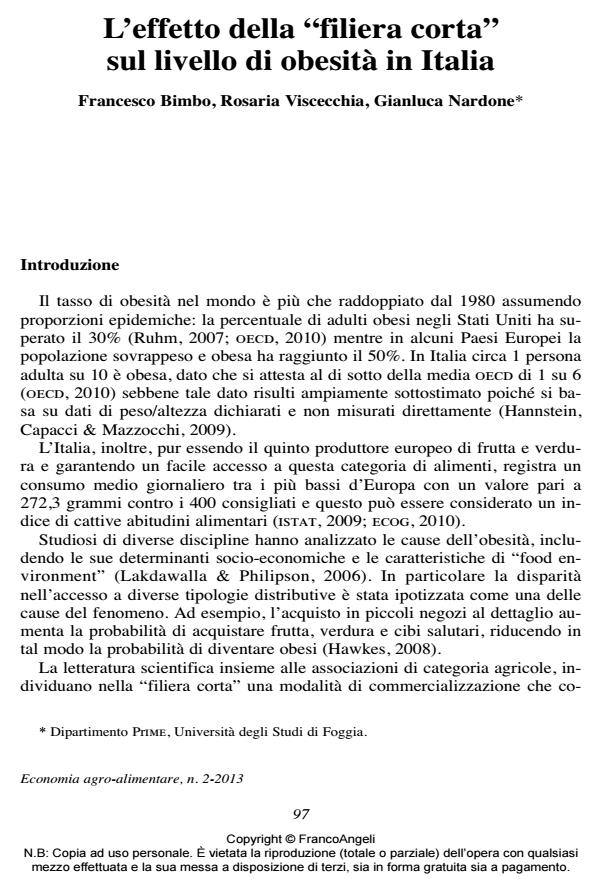L’effetto della "filiera corta" sul livello di obesità in Italia
Titolo Rivista ECONOMIA AGRO-ALIMENTARE
Autori/Curatori Francesco Bimbo, Rosaria Viscecchia, Gianluca Nardone
Anno di pubblicazione 2013 Fascicolo 2013/2
Lingua Italiano Numero pagine 14 P. 97-110 Dimensione file 113 KB
DOI 10.3280/ECAG2013-002006
Il DOI è il codice a barre della proprietà intellettuale: per saperne di più
clicca qui
Qui sotto puoi vedere in anteprima la prima pagina di questo articolo.
Se questo articolo ti interessa, lo puoi acquistare (e scaricare in formato pdf) seguendo le facili indicazioni per acquistare il download credit. Acquista Download Credits per scaricare questo Articolo in formato PDF

FrancoAngeli è membro della Publishers International Linking Association, Inc (PILA)associazione indipendente e non profit per facilitare (attraverso i servizi tecnologici implementati da CrossRef.org) l’accesso degli studiosi ai contenuti digitali nelle pubblicazioni professionali e scientifiche
Obesity rate worldwide have more than doubled since the 1980s, reachingunprecedented level, it has exceeded 30% in the U.S. while in some EuropeanCountries the population being overweight and obese has reached 50% (oecd, 2010).In Italy about 1 over 10 adults are obese, below the oecd average of 1 over 6, butthese data come from-self reported individuals weight and height and could alreadybe severely underestimated (Hansstein et al., 2009; oecd, 2010). Lastly, Italy is thethird largest spender among the eu-15 in terms of direct health-care and indirect costdue to the obesity, around its € 4.7 billion (Fry and Finley, 2005).Our study aims to evaluate the impact of local food retail systems such asfarmers’ market and farmers who sell directly from farm, on adult obesity level inItaly since preliminary evidence demonstrated that buying local food in farmers’markets has positive influence both on food habits both on health (Pascucci S. et al.,2011).We use a cross-section of individual-level data on bmi and others individualcharacteristics, from the Multipurpose Survey of Households: Aspect of Daily Lifeof the Italian National Institute of Statistics (istat), year 2009, matched withregional-level data on food outlets density such as farmers’ market, and farmers whosell directly from farm (Fondazione campagna amica - Coldiretti, OsservatorioNazionale del Commercio, 2009). Food store location endogeneity was accounted foradopting an IV estimation method exploiting variation in supply-side factorsimpacting the location decision of different food retailers.The study shows the evidence that the having access to local food is associated toa reduction in obesity rate. In particular, we found that the having access to farmers’market and farmers who sell directly from farm reduce the bmi of "0.55 and "0.12respectively. These evidences confirm the importance to promote "direct saleformat" in order to improve not only farmers’ profitability but also consumers’ wellbeingwith consequent reduction of obesity health-care costs.
Parole chiave:Obesity, food access, farmers’ market
Jel codes:I18, Q18
Francesco Bimbo, Rosaria Viscecchia, Gianluca Nardone, L’effetto della "filiera corta" sul livello di obesità in Italia in "ECONOMIA AGRO-ALIMENTARE" 2/2013, pp 97-110, DOI: 10.3280/ECAG2013-002006